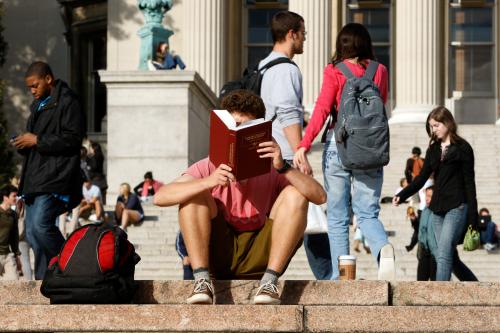This blog post summarizes the findings of the paper, “Policies and payoffs to addressing America’s college graduation deficit” written by Christopher Avery, Jessica Howell, Matea Pender, and Bruce Sacerdote and part of the Fall 2019 edition of the Brookings Papers on Economic Activity. Read summaries of all six papers from the journal here.
Last fall, about 70 percent of the high school class of 2018 was enrolled in college, but less than half will eventually graduate with a BA. Education increases productivity, enhances economic security (especially during economic downturns), and results in higher wages and wage growth. Americans seem to have received this message, since rates of college enrollment continue to rise. But, what about keeping students enrolled through graduation?
In “Policies and Payoffs to Addressing America’s College Graduation Deficit,” Christopher Avery, Jessica Howell, Matea Pender, and Bruce Sacerdote perform a timely, relevant, and illuminating cost-benefit analysis among competing proposals to increase college-going and completion. In their analysis they are clear about the question and the goal: what is the most efficient way to increase graduation rates at public four-year institutions?
The short answer is: raising per-pupil instructional spending at public institutions. Relevant to current policy debates, providing free community college does not have the downstream effect of raising BA graduation rates.
Public institutions matter because the majority of students, and especially low-income students, are enrolled there. Figure 1 shows bachelor’s degree completions rates by family income, what type of institution a student attended (public two-year, public four-year, and private non-profit four-year) by the student’s SAT or PSAT score for the high school class of 2007. Graduation rates for low-income students at public institutions lag behind students of similar ability at every point in the SAT score distribution. A low-income student at a four-year public with an SAT score above 1500 is about as likely to graduate with a bachelor’s degree as a high income student at a private four-year with an SAT score between 1200 and 1290. A low-income student with an SAT-score between 1300 and 1390 who starts at a community college is as likely to graduate six years later with a bachelor’s degree as a high income student who starts at a four-year with an SAT score less than 800.

Avery, Howell, Pender, and Sacerdote simulate the effects of four policies that might increase graduation rates by inducing students to change institutional sectors or enroll in a different institution because of tuition cuts or increasing per-pupil spending: providing tuition-free two-year college, reducing the cost of college, either by lowering the sticker price of public four-years by 10 percent or through the targeted elimination of tuition and fees to income-eligible students, raising instructional spending at public two- and four-years, and increasing the number of seats at public four-years to reduce the number of students not attending the best school that they should be able to get into.
Figure 2 summarizes their results (from table 8 in the paper). They find that free community college programs reduce four-year degree completion rates. While free community college alone would induce 15 percent of those not enrolled at a postsecondary institution to do so, it would also pull a substantial share of students away from enrollment in four-year public (6.8%) and private (5.8%) institutions.

The largest, though most expensive, way to increase graduation rates would come from a massive expansion in seat supply to ensure that students have in-state options that work for them. While both increasing seats in a more limited way and instructional spending induce the same change in bachelor’s completion rates, increasing instructional spending is half as expensive as providing more seats.
Avery, Howell, Pender, and Sacerdote are clear that their goal in this paper is to assess competing plans to increase four-year graduation rates. And the evidence for these spending subsidies, from David Deming and Chris Walters, is compelling. But their winner – increasing per-pupil spending on core academic services – includes a 10% increase in instructional spending on community college as well as leveling up instructional spending at public four-years. There is additional good evidence that similar types of spending at community colleges, from evaluations of the Accelerated Study in Associate Programs program which provided wrap-around academic and student support services to community college students, doubled graduation rates in New York and Ohio.
One option for a policy path forward? Deming has a Hamilton Project proposal to raise institutional spending at public postsecondary institutions. Deming proposes a 1:1 federal matching grant for states that implement free college at their public postsecondary institutions – with a catch. These schools would only be allowed to use these resources on core instruction and academic support services. While research evidence from pre-k to postsecondary has clearly consolidated around the idea that “money matters,” Deming’s proposal puts up guardrails for institutions to spend the money on what works; and, what Avery, Howell, Pender, and Sacerdote newly show is the most efficient way to increase graduation rates at four-year public postsecondary institutions.
The Brookings Institution is committed to quality, independence, and impact.
We are supported by a diverse array of funders. In line with our values and policies, each Brookings publication represents the sole views of its author(s).





Commentary
The most cost-effective ways to increase college graduation rates
September 5, 2019